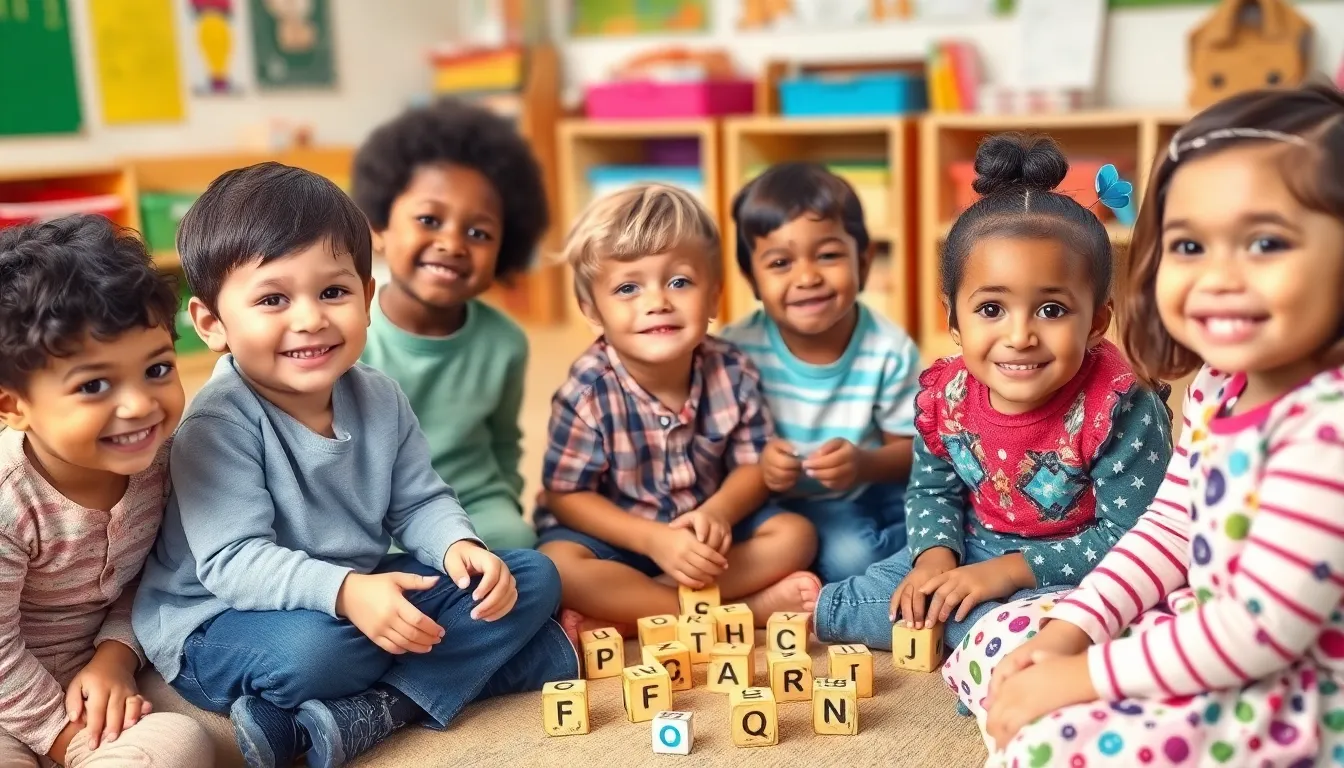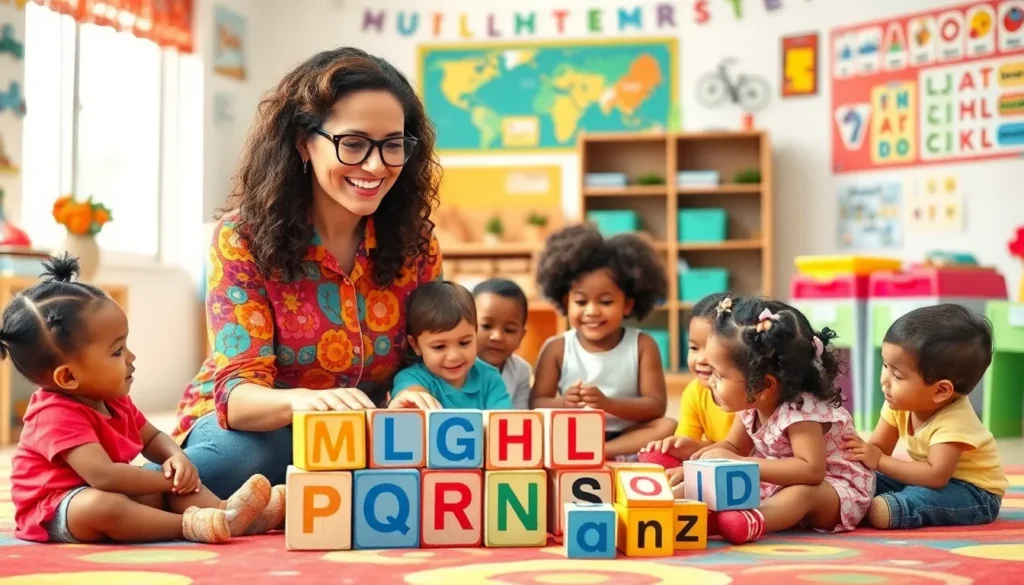Table of Contents
ToggleIn the whimsical world of preschool, where crayons and giggles reign supreme, phonics emerges as the magical key to unlocking the treasure chest of reading. It’s not just about sounding out letters; it’s about transforming tiny tots into confident readers, ready to conquer the world—one story at a time. Imagine the joy on their faces as they decode the mysteries of words, like tiny detectives on a literary mission.
But wait! Phonics isn’t just a buzzword thrown around by educators. It’s the secret sauce that makes learning fun and engaging. With playful activities and catchy rhymes, preschool phonics turns the daunting task of reading into a delightful adventure. So, buckle up as we dive into the colorful realm of phonics, where every letter is a new friend and every word is a step toward a brighter future.
Overview of Preschool Phonics
Preschool phonics serves as a foundational component in early literacy. This method enables children to understand the relationship between sounds and letters, fostering essential reading skills. Through interactive activities, kids experience joy while learning how letters form sounds and words.
Engaging games and playful exercises capture the attention of preschoolers, making lessons enjoyable. For example, rhyming songs strengthen sound recognition, which is crucial for reading fluency. Visual aids reinforce letter connections, facilitating a deeper understanding of phonetic patterns.
Teachers use structured phonics programs tailored to meet diverse learning needs. Effective instruction includes systematic introduction of consonants and vowels. Introducing simple sound combinations encourages children to blend sounds into words, enhancing their reading capabilities.
Familiarity with phonics vocabulary prepares children for successive learning stages. Familiar words, such as “cat” and “dog,” provide relatable references as children decode text. Repetition through books and songs solidifies these concepts, ensuring retention.
Incorporating phonics into daily routines supports language development. Engaging discussions promote spoken language skills while reinforcing phonetic knowledge. Enriching environments filled with print, labels, and phonics displays nurture a love for reading.
Overall, preschool phonics transforms the approach to literacy. It turns challenging concepts into accessible, enjoyable experiences. Young learners gain confidence and develop a strong foundation that supports their future reading journey.
Importance of Preschool Phonics

Phonics plays a critical role in early literacy development. It equips children with the tools to connect sounds to letters, forming the basis for effective reading. Teaching phonics through engaging activities fosters a love for learning. Young learners absorb phonetic sounds while participating in interactive games and singing rhymes.
Early Literacy Development
Understanding letter sounds occurs at a foundational level in preschool. Phonics training allows children to recognize letters and their corresponding sounds. Structured programs introduce consonants and vowels systematically, promoting sound blending. Teachers emphasize repetition through books, helping solidify these initial concepts. This method supports children’s ability to decode words, an essential skill that lays the groundwork for future reading and comprehension.
Boosting Reading Skills
Boosting reading skills relies heavily on phonics instruction. Children experience improved word recognition and decoding skills when phonics is integrated into lessons. Consistent practice with phonics increases confidence, enabling preschoolers to approach reading with enthusiasm. Engaging phonetic activities, such as decoding simple words and recognizing patterns in text, enhance literacy development. As familiarity with phonics grows, preschoolers experience an enhanced ability to read fluently, setting the stage for successful reading experiences in their academic journey.
Approaches to Teaching Preschool Phonics
Engaging preschoolers in phonics involves various methods that enhance their understanding of sounds and letters. Effective approaches promote literacy through interactive experiences.
Phonics Programs
Structured phonics programs present systematic ways to introduce letters and sounds. These programs focus on consonants and vowels, helping children recognize relationships between them. Programs often use explicit instruction along with opportunities for practice. Teachers guide students through blending sounds to form words, reinforcing learning with visuals and manipulatives. Consistent exposure solidifies foundational skills, making children confident in their reading abilities. High-quality phonics programs also accommodate diverse learning styles, ensuring all children progress at their own pace.
Play-Based Learning Techniques
Play-based learning techniques enrich phonics instruction by integrating fun activities. Through games and hands-on experiences, children engage with letters and sounds naturally. Activities such as rhyming games or auditory discrimination tasks strengthen their phonemic awareness. Singing songs with repetitive patterns reinforces sound recognition and boosts memory retention. Interactive storytelling sessions captivate preschoolers, making learning enjoyable while fostering a love for reading. Teachers can create centers where children explore phonics through play, allowing them to master skills in an inviting environment.
Challenges in Preschool Phonics
Preschool phonics, while essential, presents various challenges that educators and parents encounter. Understanding these challenges helps in devising effective strategies for instruction.
Common Misunderstandings
One significant misunderstanding is that phonics only involves letter recognition. Many believe that sounding out letters alone leads to reading proficiency. In reality, phonics requires a deeper understanding of sound-letter relationships. Children also often confuse similar-sounding letters or struggle with vowel sounds. For example, the distinction between short and long vowel sounds may confuse some preschoolers. Such confusion can affect their reading fluency and overall comprehension. Engaging teachers who clarify these concepts play a crucial role in addressing misunderstandings.
Addressing Diverse Learning Needs
Addressing diverse learning needs is crucial in preschool phonics. Each child learns at their pace, and variations in cognitive abilities require tailored approaches. Some children may thrive with visual aids, while others benefit from auditory activities. Using interactive games can engage different learning styles effectively. Additionally, incorporating songs enhances phonemic awareness and makes learning fun. Teachers often implement small group sessions to cater to varying levels of understanding, enabling peers to support each other. Providing resources aligned with each child’s unique needs fosters an inclusive learning environment.
Preschool phonics is a vital stepping stone in a child’s literacy journey. By integrating fun and engaging activities into learning, it fosters a love for reading while building essential skills. The structured approach to teaching phonics not only helps children recognize sounds and letters but also boosts their confidence in reading.
As preschoolers explore the world of phonics through games and songs, they develop a strong foundation that will support their future academic success. Embracing diverse learning styles ensures that every child can thrive in this exciting phase of education. Ultimately, preschool phonics transforms reading into a joyful adventure, setting the stage for lifelong learning.







